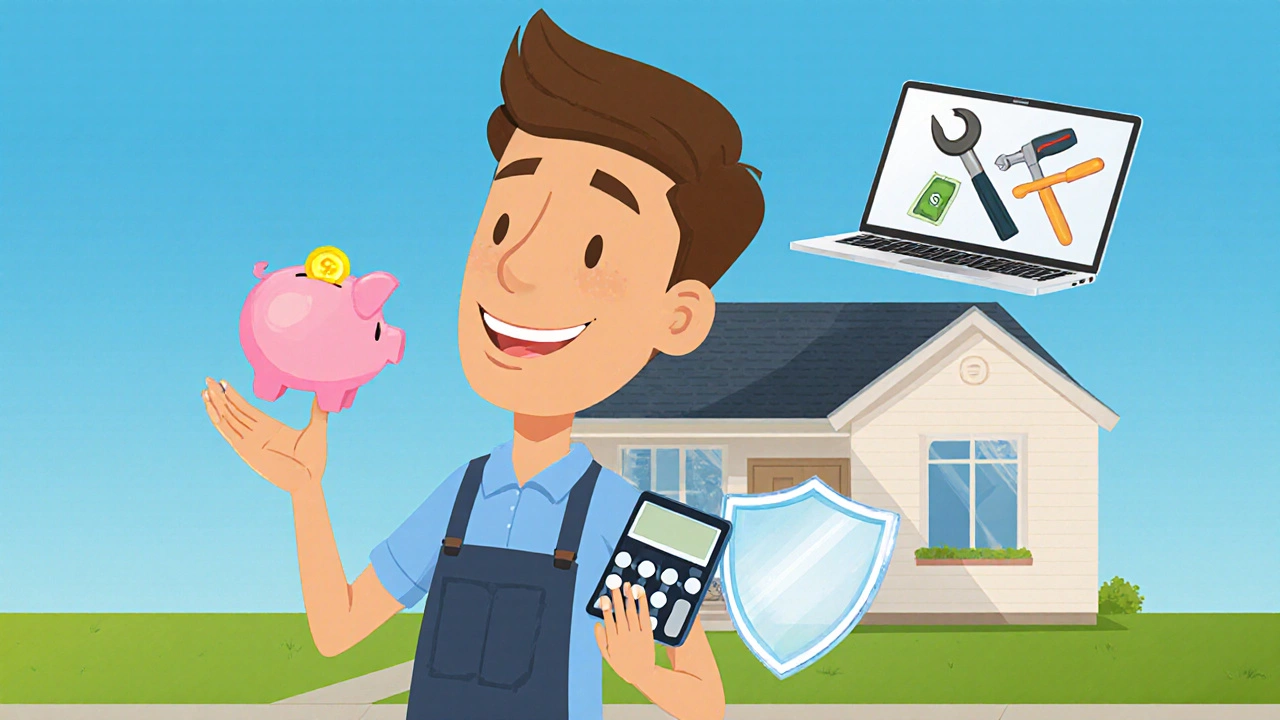Home Equity Extraction Calculator
Estimated Costs & Risks
Enter your details and click "Calculate Total Cost" to see the breakdown of your equity extraction.
Key Considerations
- 1 Your loan-to-value (LTV) ratio: --%
- 2 Estimated total interest paid: €--
- 3 Closing costs: €--
- 4 Net cash received: €--
- 5 Risk level: --
Comparison Table
| Feature | Home Equity Loan | HELOC | Cash-Out Refinance | Personal Loan |
|---|---|---|---|---|
| Repayment Style | Fixed payment | Variable interest | Fixed or variable | Fixed payment |
| LTV Limit | 80% | 85% | 80-90% | 0% (unsecured) |
| Interest Rate Range | 3.5%-5.5% | 4%-7% (variable) | 2.8%-5% (mortgage rates) | 5%-12% |
| Closing Fees | 2-4% | 1-2% | 1-3% | 0-1% |
| Tax Deductibility | Home improvement only | Home improvement only | Mortgage interest | Never deductible |
Pulling the plug on the equity you’ve built in your house feels like a quick fix when cash runs low, but the hidden costs often outweigh the short‑term gain. Below you’ll see what actually happens when you tap your home’s value, the financial traps that most borrowers miss, and safer ways to cover a shortfall.
How equity extraction works
There are three common ways to turn home equity into cash:
- Home equity loan is a lump‑sum loan secured by your property. It usually carries a fixed interest rate and a set repayment term.
- Cash‑out refinance replaces your existing mortgage with a larger one, giving you the difference in cash.
- Home equity line of credit (HELOC) works like a credit card: you draw funds as needed up to a limit, paying interest only on the amount you use.
All three products require a loan‑to‑value (LTV) ratio, which measures the loan amount against your home’s appraised value. Lenders typically cap LTV at 80% for a cash‑out refinance and 85% for a HELOC, meaning you must keep at least 15-20% equity as a safety buffer.
Why the idea sounds tempting
Most homeowners hear a familiar pitch: "You’ve paid down your mortgage, your house is worth more, so you can borrow against that extra value at a lower rate than a credit‑card or personal loan." The appeal is clear-access to a large sum, often at a rate that feels affordable.

The hidden costs that turn the bargain sour
Every time you borrow against your home, you add debt that must be repaid no matter what. Below are the most common pitfalls.
- Higher interest over the long run. Even a modest 0.5% increase above your current mortgage rate adds thousands of euros in extra interest over a 15‑year term.
- Closing and origination fees. Lenders charge appraisal fees, legal costs, and processing fees that can total 2-4% of the loan amount.
- Reduced equity cushion. If the housing market dips, you could end up owing more than the house is worth, making refinancing or selling painful.
- Risk to credit score. Missed payments on a home‑secured loan impact your credit just like a mortgage default, but the damage feels more personal because it threatens your roof.
- Tax implications. In many jurisdictions, interest on a home equity loan is only deductible when the money is used for major home improvements, not for debt consolidation or vacations.
- Debt‑to‑income (DTI) spike. Adding a new monthly payment can push your DTI above the 43% threshold lenders use, limiting future borrowing power.
When taking equity might make sense
Not every equity pull is a disaster. A few scenarios where the math can work out:
- Funding a high‑return investment, such as a renovation that adds 15%+to the property’s value.
- Covering a short‑term cash crunch (e.g., medical emergency) where you have a solid repayment plan.
- Consolidating high‑interest credit‑card debt with a fixed‑rate loan that saves you money each month.
Even in these cases, you should run the numbers: compare the total interest, fees, and risk of losing equity against cheaper alternatives.
Safer alternatives to tapping home equity
If the goal is to free up cash without endangering your biggest asset, consider these options first:
- Personal loan from a credit union or online lender. Interest rates are higher than a mortgage but often lower than credit‑card rates, and there’s no risk to your home.
- Emergency fund. Building a buffer of three to six months’ expenses in a high‑yield savings account can prevent the need for a lump‑sum loan.
- Budget tightening. Trimming discretionary spending can free up 5-10% of your monthly cash flow without any borrowing.
- Refinance without cash out. A lower‑rate mortgage reduces your monthly payment, freeing up cash without increasing debt.
- Side‑hustle income. Freelancing, consulting, or renting a spare room can generate extra cash without touching equity.

Quick checklist before you click ‘apply’
- Calculate your current LTV. Keep at least 15% equity untouched.
- List every fee (appraisal, attorney, title insurance) and add them to the loan amount.
- Run a 5‑year total‑cost comparison: home equity loan vs personal loan vs no‑loan scenario.
- Check how the new payment affects your DTI and future borrowing plans.
- Confirm the interest is tax‑deductible for your intended use.
- Write a repayment timetable. If you miss a payment, how quickly can you recover?
Comparison of common equity‑extraction products
| Feature | Home Equity Loan | HELOC | Cash‑Out Refinance | Personal Loan |
|---|---|---|---|---|
| Repayment style | Fixed monthly payment, fixed rate | Interest‑only option, variable rate | New mortgage payment, fixed or variable | Fixed monthly payment, fixed rate |
| Typical LTV limit | 80% | 85% | 80‑90% (depends on lender) | 0% (unsecured) |
| Interest rate range | 3.5%‑5.5% | 4%‑7% (variable) | 2.8%‑5% (mortgage rates) | 5%‑12% |
| Closing fees | 2‑4% of loan | 1‑2% (appraisal, setup) | 1‑3% (standard mortgage fees) | 0‑1% (origination) |
| Tax deductibility | Only for home‑improvement use | Only for home‑improvement use | Mortgage interest deductible (subject to limits) | Never deductible |
Frequently Asked Questions
Can I use a home equity loan to pay off credit‑card debt?
Yes, but the savings only make sense if the loan’s interest rate is lower than your credit‑card rates and you’re confident you won’t miss payments. Remember that the loan is secured by your house, so a missed payment could lead to foreclosure.
What happens if my home’s value drops after I take out equity?
Your LTV rises, which can limit future refinancing options and may trigger a demand for additional collateral if your lender has a “negative equity” clause. In extreme cases you could owe more than the house is worth.
Are there any tax benefits to a home equity line of credit?
Only if the borrowed funds are used for qualified home‑improvement projects. Using the line for vacations or car purchases makes the interest non‑deductible.
How do closing costs affect the total amount I receive?
Lenders typically charge 1‑3% of the loan amount for appraisal, legal, and processing fees. Those costs are deducted from the disbursement, so the cash you walk away with is lower than the loan’s face value.
Is a cash‑out refinance better than a home equity loan?
It can be if you can secure a lower mortgage rate and want to consolidate all debt into one payment. However, you’ll likely extend the loan term, meaning more total interest paid over time.
